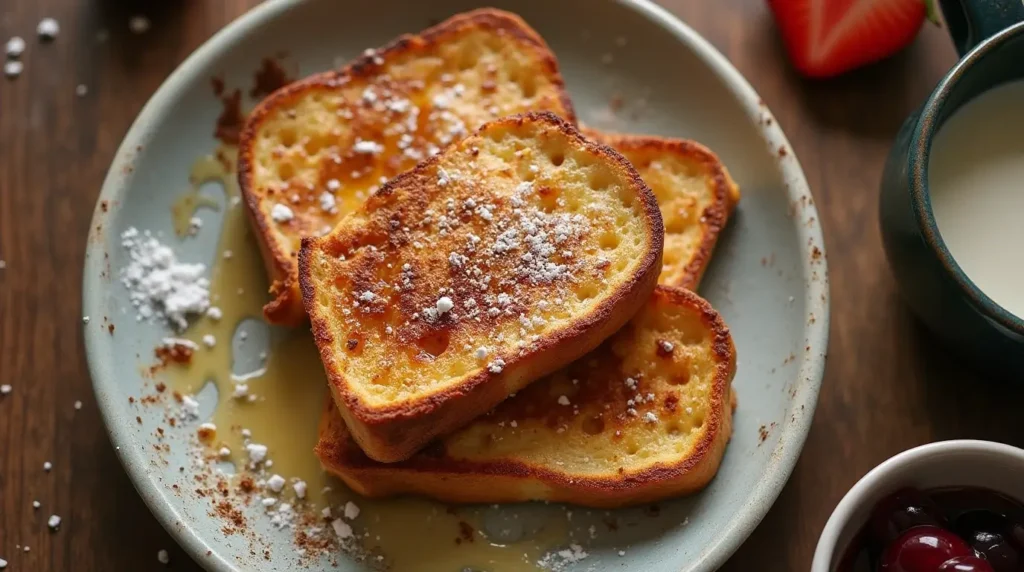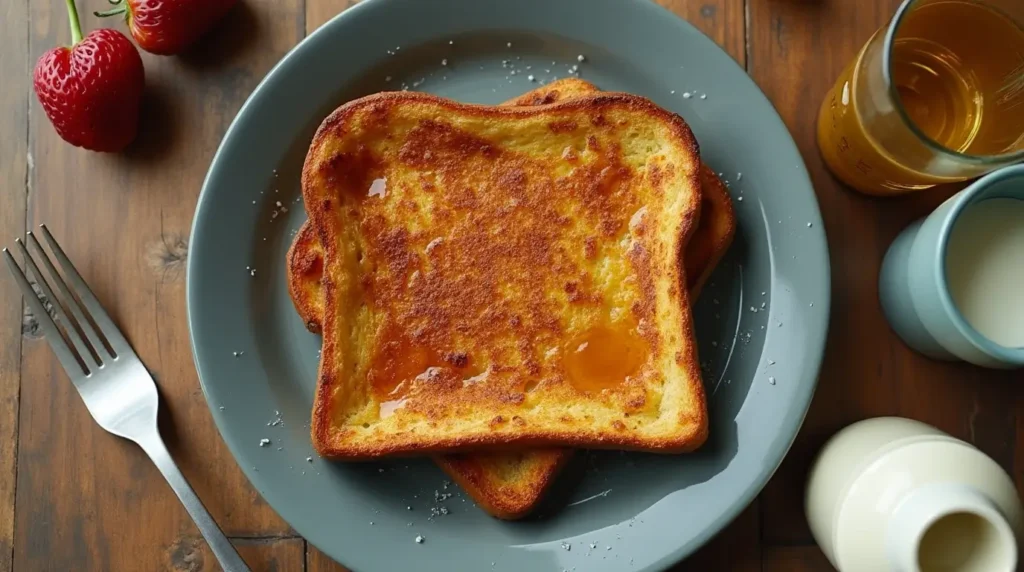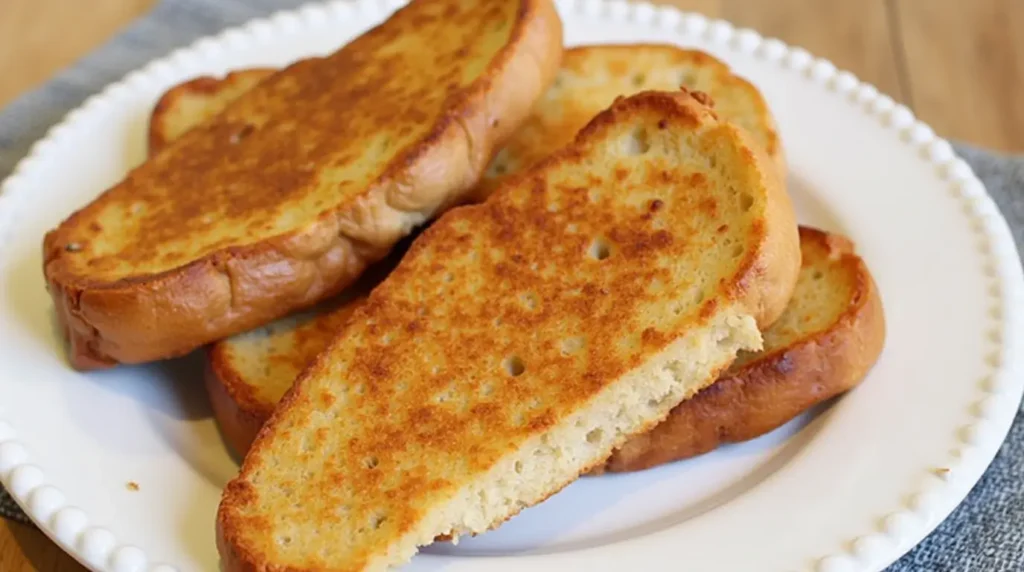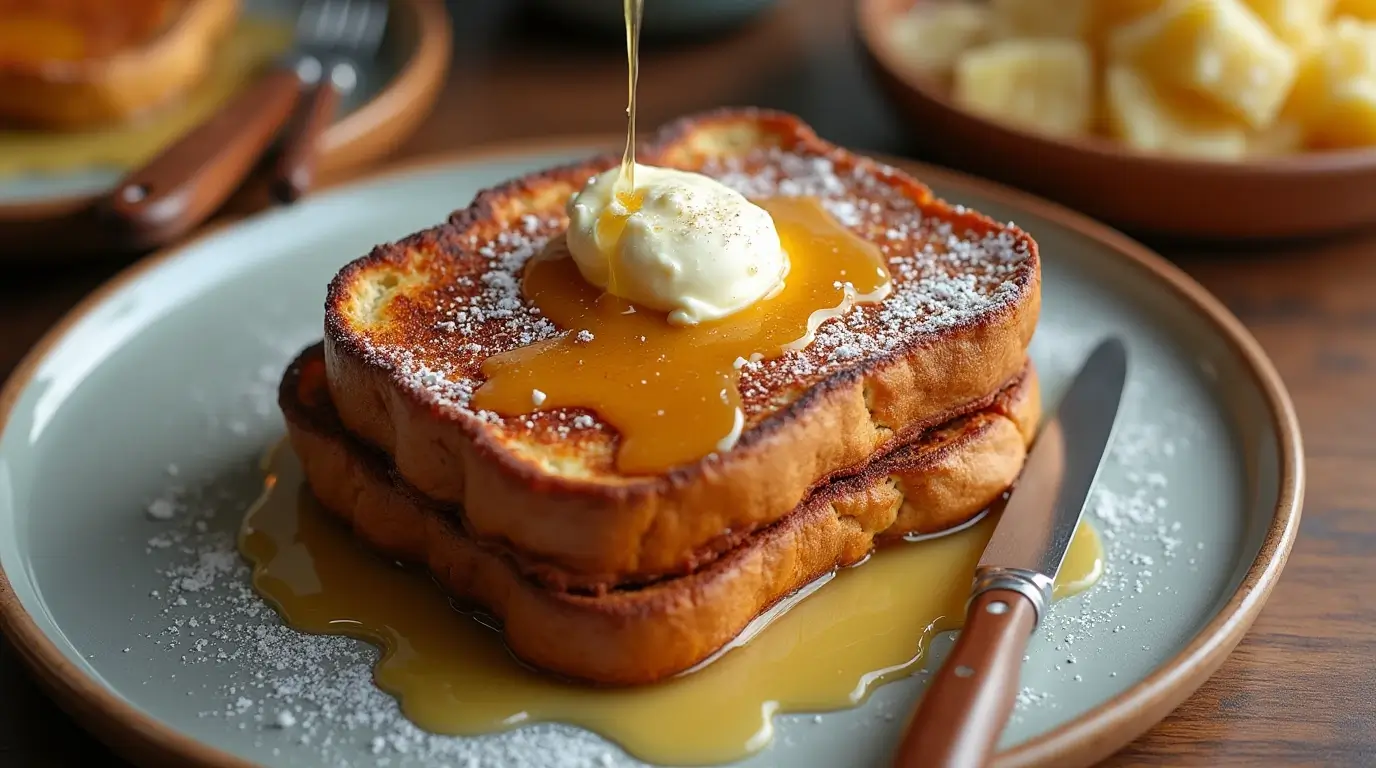Learn how to make French toast without milk using simple substitutions and tips. This guide covers everything from ingredients to serving suggestions for a delicious dairy-free breakfast.
Understanding How to Make French Toast Without Milk
Why Make French Toast Without Milk?
Many people need milk alternatives when making French toast. For example, they may have lactose intolerance or a dairy allergy. Therefore, knowing how to make French toast without milk allows everyone to enjoy this classic breakfast. In addition, it opens up possibilities for using other ingredients. Specifically, there are many great options available for those who cannot consume milk.
The Importance of the Custard Base
The custard base is critical to the success of French toast. Indeed, milk is traditionally used to create the smooth and rich custard. However, it is possible to achieve a similar texture and flavor without milk. Accordingly, finding the right substitutes is essential for achieving perfect results. Comparatively, other liquids can replicate the role of milk while keeping the taste profile on par.
Print
How To Make French Toast Without Milk
- Total Time: 15 minutes
- Yield: 2 servings 1x
Description
This easy French toast without milk is still rich, golden, and delicious perfect for dairy-free mornings using pantry staples. Crispy outside, soft inside, and ready in minutes.
Ingredients
- 4 slices thick bread (day-old works best)
- 2 large eggs
- 1/4 cup water or orange juice
- 1 tablespoon maple syrup or sugar
- 1/2 teaspoon cinnamon
- 1/2 teaspoon vanilla extract
- Pinch of salt
- Butter or oil, for the pan
- Optional toppings: fresh fruit, syrup, powdered sugar
Instructions
- 1. In a shallow bowl, whisk together eggs, water or orange juice, maple syrup, cinnamon, vanilla, and salt.
- 2. Heat a skillet or griddle over medium heat and lightly grease with butter or oil.
- 3. Dip each slice of bread into the egg mixture, coating both sides well.
- 4. Place dipped bread on the skillet and cook for 2–3 minutes per side, until golden brown and cooked through.
- 5. Repeat with remaining slices.
- 6. Serve warm with your favorite toppings.
Notes
- Orange juice adds a subtle brightness—water works great too.
- Use dairy-free butter to keep it fully dairy-free.
- Try with cinnamon-raisin or sourdough bread for extra flavor.
- Prep Time: 5 minutes
- Cook Time: 10 minutes
- Category: Breakfast
- Method: Pan-Fried
- Cuisine: American
Nutrition
- Serving Size: 2 slices
- Calories: 270
- Sugar: 6g
- Sodium: 330mg
- Fat: 11g
- Saturated Fat: 3g
- Unsaturated Fat: 6g
- Trans Fat: 0g
- Carbohydrates: 30g
- Fiber: 2g
- Protein: 10g
- Cholesterol: 170mg
Keywords: french toast without milk, dairy-free french toast, easy french toast, no milk breakfast
Essential Ingredients for Dairy-Free French Toast Without Milk
Bread: The Foundation of French Toast Without Milk
The type of bread used dramatically impacts the final product. For example, thick-cut slices of brioche or challah bread work exceptionally well. Generally, these types of bread are sturdy and soak up the custard evenly. However, regular white or whole wheat bread can also be used successfully. In addition, consider using slightly stale bread, which absorbs the custard better.
Egg Substitutes and Their Role
Eggs are a crucial part of the custard. Indeed, they provide structure and richness to the French toast. For example, use whole eggs or egg whites, depending on preference. Furthermore, you can use flax eggs as a vegan option if you’d like. Specifically, consider the texture and binding properties of the substitute you use.
Liquid Substitutes for Milk
Finding the right liquid substitute is key when learning how to make French toast without milk. For instance, plant-based milk like almond, soy, or oat milk works perfectly. Similarly, coconut milk or even water can also be used with adjustments. Indeed, these substitutes maintain the correct moisture content and texture. Also, consider using a combination of different liquids to achieve the desired flavor and consistency.
Sweeteners and Spices
Sweeteners and spices enhance the flavor of the French toast without milk. Therefore, add a touch of sugar, maple syrup, or honey to the custard base. In addition, use a dash of cinnamon, nutmeg, or vanilla extract for extra flavor. Specifically, consider experimenting with different combinations to achieve your preferred taste. Indeed, these additions can make your French toast stand out.
Step-by-Step Guide to Making French Toast Without Milk

Preparing the Custard French Toast Without Milk
In a shallow bowl, whisk together your chosen liquid substitute for milk, eggs, sweeteners, and spices. Then, whisk thoroughly until all ingredients are well combined. This will ensure the custard is smooth and ready for dipping. Consequently, your custard will be rich and have a nice texture.
Dipping the Bread
Dip each slice of bread into the custard, allowing it to soak for a few seconds on each side. However, be careful not to soak the bread for too long. Accordingly, overly soaked bread may become too soggy. Similarly, make sure the bread is evenly coated with the custard.
Cooking the French Toast Without Milk
Heat a lightly oiled griddle or non-stick pan over medium heat. Then, place the dipped bread slices onto the hot surface. Cook for 2-3 minutes per side or until golden brown and cooked through. Eventually, carefully flip the slices to cook the other side. Likewise, do not overcook or burn the bread.
Serving and Garnishing
Serve the French toast without milk immediately. Finally, you can add toppings like fresh fruit, maple syrup, powdered sugar, or whipped cream. Also, consider using a variety of toppings to make the breakfast more appealing. Undeniably, this step is all about presentation and flavor enhancement.
Tips for Making the Best French Toast Without Milk
Achieving the Perfect Custard Consistency
The consistency of the custard is crucial. Specifically, aim for a smooth and slightly thick texture. In addition, if the custard appears too thin, whisk in a bit more egg. Conversely, if too thick, add a splash more of your chosen milk substitute. Consequently, the perfect consistency will ensure your bread absorbs it evenly.
Soaking the Bread Properly French Toast Without Milk
The key to good French toast is soaking the bread just right. Specifically, do not soak the bread for too long. This can result in soggy French toast. Also, ensure that you do not soak it too little, which could result in dry French toast. Therefore, aim for a balance to achieve a perfectly moist center.
Cooking at the Right Temperature
Cook french toast over medium heat. Specifically, avoid cooking it over high heat, which can result in burnt bread with a raw center. Also, avoid low heat, which may result in overly dry and hard bread. Similarly, achieving the right heat is key to even cooking and a golden-brown crust.
Choosing the Best Toppings French Toast Without Milk
Choosing the right toppings can enhance the overall flavor. For example, fresh berries, sliced bananas, and a drizzle of maple syrup always taste great. In addition, consider a sprinkle of chopped nuts or a dusting of powdered sugar. Indeed, these small touches can make a big difference in the overall presentation and taste.
Variations on French Toast Without Milk
Using Different Types of Bread
Experiment with different types of bread. For example, try using sourdough, croissants, or even leftover cake. Specifically, the type of bread will dramatically influence the overall taste and texture of the dish. Likewise, exploring various bread types can lead to new and exciting flavor combinations.
Adding Different Spices and Extracts
Explore a variety of spices and extracts to change the flavor profile. For instance, use cardamom, ginger, or almond extract. Also, you can use citrus zest to add a refreshing flavor. Indeed, these additions can create endless variations.
Incorporating Different Fruits and Flavors
Add mashed bananas or berries directly to the custard. This will add a natural sweetness and enhance the overall flavor. Also, you can add a touch of citrus zest or a splash of coffee for additional flavor layers. Similarly, experimenting with these flavors can lead to unique and delightful results.
Savory French Toast Options
Transform french toast into a savory dish. For example, omit the sugar and vanilla. Instead, use herbs like thyme or rosemary and add a pinch of salt and pepper. Specifically, top it with a fried egg, avocado, or some crumbled feta cheese. This can provide a great alternative to the traditional sweet version.
Dairy-Free Substitutes Explained French Toast Without Milk

Plant-Based Milk Options French Toast Without Milk
Plant-based milks such as almonds, soy, oats, and coconut milk are excellent substitutes. For example, almond milk is light and mild, while soy milk adds richness. Therefore, choose a milk based on your personal preference and dietary needs. Additionally, consider using a blend of different milks for a unique flavor.
Coconut Milk Considerations
Coconut milk adds a creamy richness to the French toast. Specifically, it is a great substitute if you want a richer flavor. However, be aware that it will also add a slight coconut flavor. Therefore, use it sparingly or if you want a coconut flavor. Indeed, it can be a delicious alternative for those who like coconut.
Water as a Last Resort
While not ideal, water can be used as a last resort. For example, if no other liquid substitutes are available. However, it is generally recommended to add more eggs and sugar to the custard. Therefore, water will create a lighter texture, and it may not soak into the bread as well. Specifically, it might require adjustments to seasonings.
Comparing Different Substitutes
Each substitute will produce different results. For example, some may lead to a richer, creamier texture, while others may result in a lighter, more delicate french toast. Therefore, it’s important to experiment with different options to find your favorite. Indeed, the best substitute depends on your preferences and what you are looking for in your dish.
How to Make French Toast Without Milk: A Global Perspective
French Toast Around the World
French toast is enjoyed in many different countries. Specifically, it may be called by different names and use slightly different techniques. For example, in some countries, it is traditionally served with savory toppings. Therefore, understanding these variations can offer a new perspective on the dish. Indeed, french toast is a versatile dish loved in various forms globally.
Variations in Custard Ingredients
The custard base for French toast also varies around the world. In some places, they use condensed milk, while others may use specific regional spices. Therefore, experimenting with global variations of French toast can open up a whole new range of flavors. Ultimately, the custard is what creates the unique flavors in each dish.
Different Cultural Toppings
Toppings vary from region to region. For example, some places serve it with fruit and honey. Conversely, others use spices and cheese. Indeed, exploring global topping ideas can add new levels of excitement to your breakfast routine. Therefore, experimenting with different toppings from around the world is an easy and fun activity.
Health and Nutritional Information French Toast Without Milk

Calorie Content and Considerations French Toast Without Milk
The calorie content of French toast varies. This is because it depends on the ingredients used. For instance, using whole wheat bread and plant-based milk can help reduce calorie content. Similarly, limiting added sugars and using fresh fruit toppings can also help you make a healthier dish. Ultimately, consider your overall diet when selecting your toppings.
Key Nutrients in French Toast Without Milk
French toast can provide essential nutrients. Specifically, eggs provide protein. In addition, the bread provides carbohydrates. Therefore, consider using whole wheat bread and adding fruit toppings to boost nutrient intake. Furthermore, plant-based milks also add nutritional benefits to the dish.
Adjusting for Dietary Restrictions
French toast can be easily modified for different dietary restrictions. For example, use gluten-free bread for those with gluten intolerance. Conversely, use plant-based milk and flax eggs for vegan versions. Thus, these adjustments can allow everyone to enjoy a serving of French toast. Indeed, simple substitutions can accommodate many dietary needs.
Making French Toast Without Milk for a Crowd
Scaling the Recipe Effectively French Toast Without Milk
Scaling the recipe for a crowd is simple. Specifically, just double or triple the ingredients. Also, make sure to use a large griddle or multiple pans. Therefore, you can accommodate a large quantity of French toast without hassle. Similarly, it helps to pre-mix the custard in a large container to speed up the cooking process.
Tips for Efficient Cooking French Toast Without Milk
Prepare the custard in advance. Then, set up a station for dipping the bread to streamline the process. Also, cook in batches to avoid overcrowding the griddle. Specifically, this will ensure the French toast is evenly cooked. In conclusion, prepare ahead and stay organized when you are cooking for a crowd.
Serving Large Groups
When serving large groups, keep the cooked French toast warm in an oven. Specifically, use a baking sheet in a warm oven to prevent it from getting cold while finishing the rest of the batch. Also, have a variety of toppings and syrups available to cater to different preferences. Indeed, these simple steps will ensure the crowd enjoys a hot and delicious breakfast.
Storing and Reheating Leftovers
Proper Storage Methods French Toast Without Milk
Store leftover french toast without milk in an airtight container. Therefore, allow the french toast to cool completely before storing it in the refrigerator. Generally, these methods keep the french toast from getting soggy while refrigerated. Also, keep the leftovers separate from any toppings and sauces.
Reheating Techniques
Reheat french toast in a toaster oven, skillet, or microwave. Specifically, the toaster oven will help to maintain the crispy texture. Conversely, a skillet can also provide a crispy texture, and you can add butter to it. Meanwhile, the microwave is quick but may result in softer texture. Therefore, choose the method based on your desired results and convenience.
Maintaining Quality After Reheating
When reheating, be careful not to overcook the French toast. Specifically, this can make it tough or dry. In addition, consider adding a touch of butter or oil when reheating in a skillet. Finally, add toppings just before serving to preserve their texture. Consequently, this ensures the quality of the French toast remains intact.
What Can I Use Instead of French Toast Without Milk?
Exploring Various Alternatives
There are many milk alternatives when making French toast. For example, try plant-based milk like almond, soy, or oat milk. Furthermore, coconut milk can also be used for a richer flavor. Likewise, even water can be used in a pinch, although it may require adjustments to other ingredients.
Plant-Based Milks: A Closer Look
Plant-based milks are great options. Each type will result in a different flavor and texture. For instance, soy milk is often considered the most like cow’s milk, while almond is lighter. Specifically, choose the type of plant milk according to your preference. Indeed, there is a great option for everyone.
Other Liquid Substitutions
Water and even coffee can be used in place of milk. However, they may require adding extra flavor and sweetness. Indeed, adding vanilla extract or sugar can help make the batter taste delicious. Therefore, remember to adjust your recipe according to the liquids you choose.
Does the Milk Matter in French Toast?
The Role of Milk in the Custard
Milk is a key ingredient in traditional French toast. Specifically, it helps create a smooth and creamy custard base. Therefore, it provides moisture for soaking the bread. In conclusion, milk greatly influences the overall texture and taste of french toast.
Substitutes That Can Replicate Milk
While milk is important, it’s not irreplaceable. For example, plant-based kinds of milk can mimic the creamy texture and flavor. Indeed, these milk alternatives can make equally delicious French toast. Therefore, the result will be excellent even without traditional milk.
The Importance of Liquid Balance
The most important factor is having the right balance of liquid. Specifically, using any liquid substitute for milk will require adjustments. This includes egg and spice ratios to achieve the perfect consistency. Consequently, achieving the correct balance ensures the best texture.
What Is the Most Common Mistake When Making French Toast Without Milk?
Over-Soaking the Bread
One of the most common mistakes is over-soaking the bread. Specifically, this leads to soggy French toast that falls apart during cooking. Therefore, avoid this issue by dipping the bread briefly on each side. Also, ensure your bread isn’t overly soft to begin with. Consequently, you should always be aware of how long you dip your bread.
Cooking at the Wrong Temperature
Cooking the french toast at the wrong temperature is another common mistake. Specifically, high heat can burn the outside. Meanwhile, low heat can result in a dry and hard texture. Therefore, always aim for medium heat for the best results. In addition, ensure the pan is evenly heated.
Not Using Enough Fat in the Pan
Not using enough oil or butter in the pan can make your French toast stick. Specifically, this prevents a nice golden crust. Also, it makes it difficult to flip without tearing the bread. Therefore, make sure to add a bit of oil or butter to prevent these issues. Indeed, these simple steps will prevent your French toast from sticking.
Can I Use Coffee Creamer for French Toast Instead of Milk?
Using Coffee Creamer as a Substitute
Coffee creamer can be used as a milk substitute in French toast. However, it tends to have a higher fat and sugar content compared to regular milk. Indeed, this can result in a richer and sweeter French toast. Therefore, use coffee creamer carefully if you intend to use it.
Types of Coffee Creamer
Different coffee creamers have different flavor profiles and textures. Specifically, some are very thick and sweet, while others are more light and subtle. Therefore, consider using a plain or lightly flavored creamer to avoid overpowering the other flavors. Indeed, consider the texture and taste profile of the creamer.
Adjusting the Recipe
When using coffee creamer, you may need to adjust the sugar and spice content. Specifically, reduce the added sugar to avoid making the French toast too sweet. Therefore, adjust other ingredients accordingly to ensure a balanced flavor. In conclusion, you should taste and tweak as you cook.
Conclusion
In conclusion, learning how to make French toast without milk is easy with the right substitutes and techniques. Specifically, plant-based milk, eggs, and simple adjustments can create delicious dairy-free French toast. Therefore, explore the tips, tricks, and variations discussed in this article to create the perfect breakfast. Remember to taste, adjust, and have fun while cooking. Ultimately, the best results come from practice and experimentation.
Need a nostalgic bite? Don’t miss our rock bottom pie—an ideal treat to layer coconut pastry cream into.

